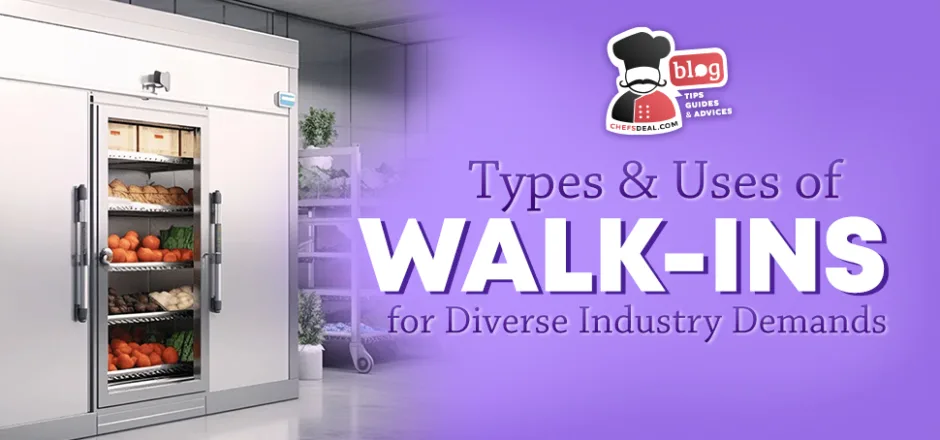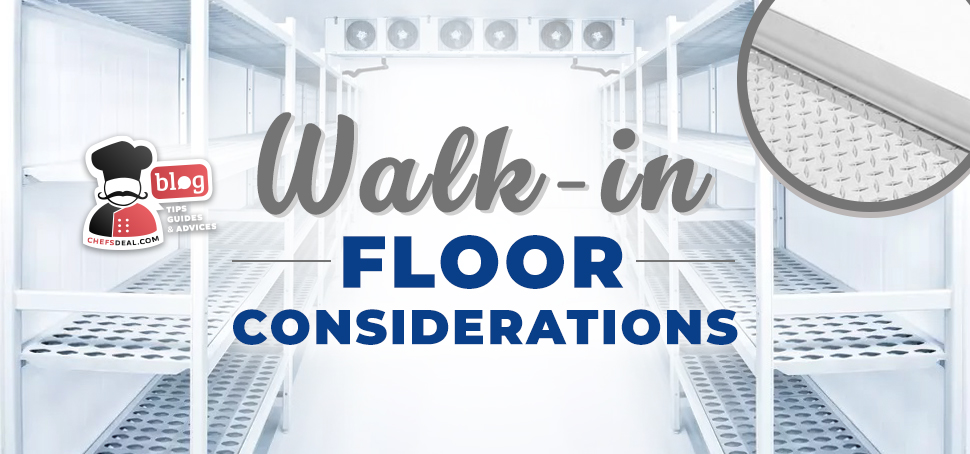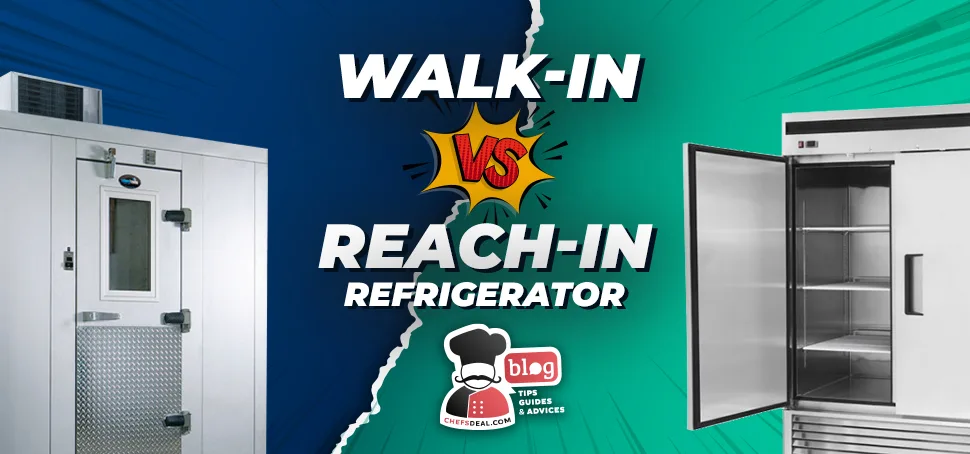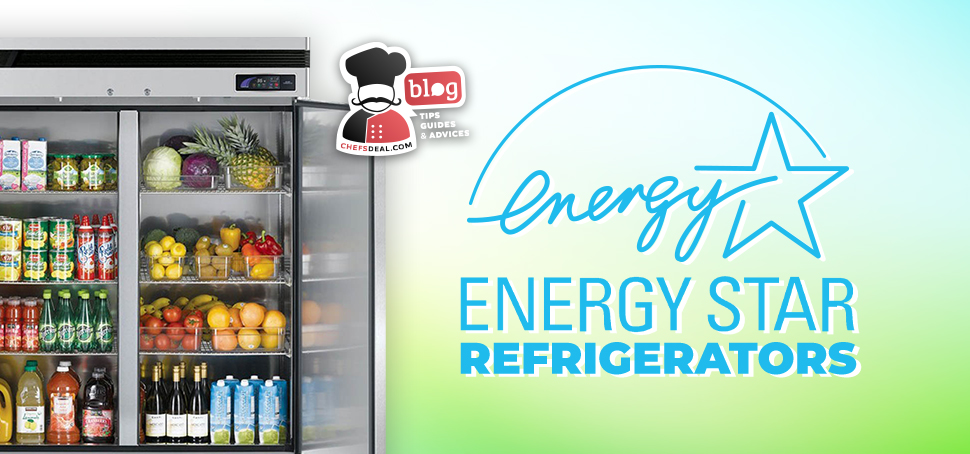The types and uses of walk-ins offer a broad catalog of choices to meet diverse industry demands. Walk-ins are large and indispensable pieces of commercial kitchen equipment for every foodservice business. Their design and function aim to be as versatile as possible to seamlessly fit in with different types of kitchens, locations, business goals, access requirements, and more.
You can judge the type and function you need in your intended unit based on 9 main considerations. Evaluate:
- Where will/should your unit be located?
- What kind of construction type do you require based on your time and space restrictions?
- What specific features does your area of work demand?
- Whether you will expand on your unit in the future with business growth,
- What kind of cooling system works best for you?
- What are your energy efficiency options?
- What kind of accessibility requirements do your staff and local codes demand?
- Whether the unit is in compliance with laws and regulations and has the necessary certifications?
- What materials are used in its making for insulation and durability purposes?
By considering these nine points, you can maximize the benefits you reap from such a big investment and ensure you keep your unit for a long time, both in terms of longevity and adaptability to growing business needs.
Location Adaptability
Indoor units and outdoor units are two types of walk-ins based on location. Outdoor units are often preferred to keep the noise and the heat outside the kitchen and gain much-needed space, while indoor units are preferred for their ease of access and to avoid the possibility of weather damage and theft. You should find out how adaptable your intended unit is to gauge whether it can function properly in the desired location. Each scenario poses different problems and advantages and has unique location requirements.
Location Adaptability Considerations for Indoor Units
- Kitchen Space: Walk-in refrigerations need to be big enough to meet your demand and small enough to fit into your space. Make sure you have enough room in your kitchen for a walk-in unit. You will need to leave space for fans to work properly and create air circulation. Federal and local codes often require you to place the unit 6″ (15.24 cm) away from the ceiling and 2″ (5.08 cm) from the walls. You can invest in an additional reach-in for storage support, opt for a remote condenser to open up space inside the unit, or get rid of unnecessary kitchen equipment like outdated and bulky machinery if you are struggling to achieve the balance between your space and capacity needs.
- Air Conditioning and Heating: Walk-in refrigerations carry out the simple mechanic of cooling the interior of the unit while removing heat. In cramped kitchens, such large equipment heats the environment with the air it expels. A sound ventilation system and sufficient refrigerant charge for the compressor prevent overheating and help the walk-in maintain desired temperatures more easily while keeping your work environment cool. Make sure the condenser coils are clean and the compressor is in good condition if you are buying second-hand. Problems in these areas can lead to overheating and significantly reduce the lifespan of the unit.
- Building Integration: Walk-in coolers and freezers need to be integrated into the building’s water, electricity, and ventilation networks. Make sure that your building can supply about 5hp power for a walk-in cooler and around 1hp for a walk-in freezer. You will need an experienced HVAC engineer to install and integrate the unit to ensure there are no leaks around fans, pumps, and drains.
- Noise: Depending on the age and build of the machinery, walk-in refrigeration systems can be quite noisy and hard to work around. To remove the noisiest part of the walk-in from your kitchen, you can look into units with remote condensers. However, you need to invest in extra cable work similar to that to establish the connection between the unit and the condenser.
Location Adaptability Considerations for Outdoor Units
- Weatherproof Features: An outdoor unit should be made of robust material to withstand weather conditions such as rain, snow, extreme temperatures, and humidity. For example, stainless steel or galvanized steel and similar materials can resist corrosion, rust, and degradation over time due to exposure to the elements. Extra thick panels provide extra security against winds, and investing in the protective weather-resistant coating can help you minimize the impact of weather on your unit and electricity bills. An additional cost-affective measure can be installing a rubber roof to provide shade and shelter from rain and snow.
- Anti-Theft Measures: Outdoor units are vulnerable to theft and vandalism, especially in unsecured locations. Implementing anti-theft measures such as advanced locks, alarms, and surveillance cameras can prevent theft and unauthorized access. You can invest in a digital lock and alarm mechanism to receive instant alerts in case of a breach.
- Accessibility: You need to establish a clear route to and from the walk-in to ensure an efficient workflow while removing the walk-in refrigeration from the kitchen, which creates room and gets rid of nuisances such as noise and heat. The system should not be too far from the kitchen, and you can implement product retrieval intervals to streamline the process. You can remove the products you will use that day at the beginning of the day and place them in a reach-in within the kitchen to minimize product retrieval trips.
Construction Type
Pre-fabricated models (quick shipping) and custom-built models are the two main construction types for walk-in units. Pre-fabricated models possess standard features and measurements that can work perfectly for most businesses. This option is cost-efficient, and the wait time is significantly shorter since the unit is already manufactured. Quick shipping of pre-fabricated walk-ins usually takes 1-3 business days. The arrival date can vary based on the distance between your restaurant and the warehouse.
Custom-built units are tailored to carry the dimensions and features you asked for. They can be customized to fit into odd-shaped spaces, have more doors, tailored shelving layouts, and more. While the customizations can be totally worth it depending on your circumstances, the design and production process of these units significantly add to the wait time. You may need to wait approximately 3 weeks for the shipment of a custom unit.
Industry-Specific Features
Walk-in units are manufactured with industry demands in mind; you can find industry-specific features on different models.
- Restaurants and Food Service: The food service industry is fast-paced and requires frequent and easy access to ingredients at all times. Walk-ins that will be used in such spaces need to account for high foot traffic, leave enough room between shelves, and possess a strong cooling mechanism to quickly recover lost temperatures from frequent door use. Consider opting for glass doors so your staff can easily see the interior and install proper display lights to locate products in such a vast storage space.
- Medical and Pharmaceutical: The Medical and pharmaceutical industry uses walk-ins to store medicines and vaccines. The temperature setting for these units could differ from their food service counterparts since medical products have very specific temperature requirements. These models have precise temperature control since vaccine and medicine spoilage is easier than food spoilage. While food can survive on residual temperatures for a short time, being out of the necessary temperature bracket can have fatal effects on pharmaceutical products. Advanced precision temperature control and monitoring systems for sensitive materials ensure that such mishaps don’t happen, and you are alerted immediately if a problem arises. Digital temperature monitors and alarms can be connected to your phone to alert you even after work hours.
- Retail and Grocery: Retail and grocery stores often utilize walk-in storage spaces to store and display meat and dairy products. This allows the business to easily store products in bulk while still allowing the customer to easily browse them. Units that are used for display and retail purposes usually have viewing windows, glass doors, precise labeling, and enhanced lighting for product display and customer attraction.
- Walk-in Mortuary Coolers: In the mortuary sector, walk-in coolers play a crucial role in respectfully preserving the deceased. These specialized units feature precise temperature controls that are paramount for mortuary applications, ensuring that bodies are stored in conditions that slow decomposition. They are often fitted with smooth, sanitary stainless steel surfaces for ease of cleaning and to maintain a sterile environment. Additionally, mortuary walk-in coolers are designed to support heavy-duty trays and racks that can hold varying weights, providing the flexibility needed for different cases.
- Walk-in Grow-Room Coolers: Walk-in grow-room coolers are engineered to foster optimal growth conditions for a variety of plants. These specialized units come equipped with precise controls for both humidity and temperature, which are critical for simulating the right environment for horticultural or cannabis cultivation. They feature unique lighting setups that can mimic the natural light spectrum required for photosynthesis. Moreover, the shelving within these coolers is designed to support the weight of plant containers and allows for easy adjustment to cater to different plant heights and growth cycles.
- Cold Storage Warehouses: Cold storage warehouses serve a pivotal role in the supply chain by keeping perishable goods fresh over extended periods. These massive walk-ins are built with industrial-grade cooling systems to ensure a consistently cold environment vital for the storage of large volumes of food, pharmaceuticals, or chemicals. They typically include dock-level entry points for easy loading and unloading, as well as high-density shelving systems that maximize storage space and facilitate inventory management.
- Walk-in Keg Coolers: For businesses in the beverage industry, walk-in keg coolers are indispensable for keeping a variety of draught beers at the perfect temperature. These coolers are equipped with reinforced flooring to withstand the weight of multiple beer kegs, along with custom tap systems for efficient dispensing. They often include insulated glass doors to minimize temperature fluctuation caused by door openings and LED lighting to enhance product visibility and selection.
- Portable Walk-in Refrigeration Units: Portable walk-in refrigeration units offer flexibility for events, emergency situations, or businesses that require movable cold storage options. These coolers are built with durable exteriors to withstand the rigors of transportation and can operate on a range of power sources, from standard electrical outlets to generators. Their interiors are versatile, with shelving that can be adjusted or removed according to storage needs. They often come with lockable doors for security when in transit or stationed outdoors.
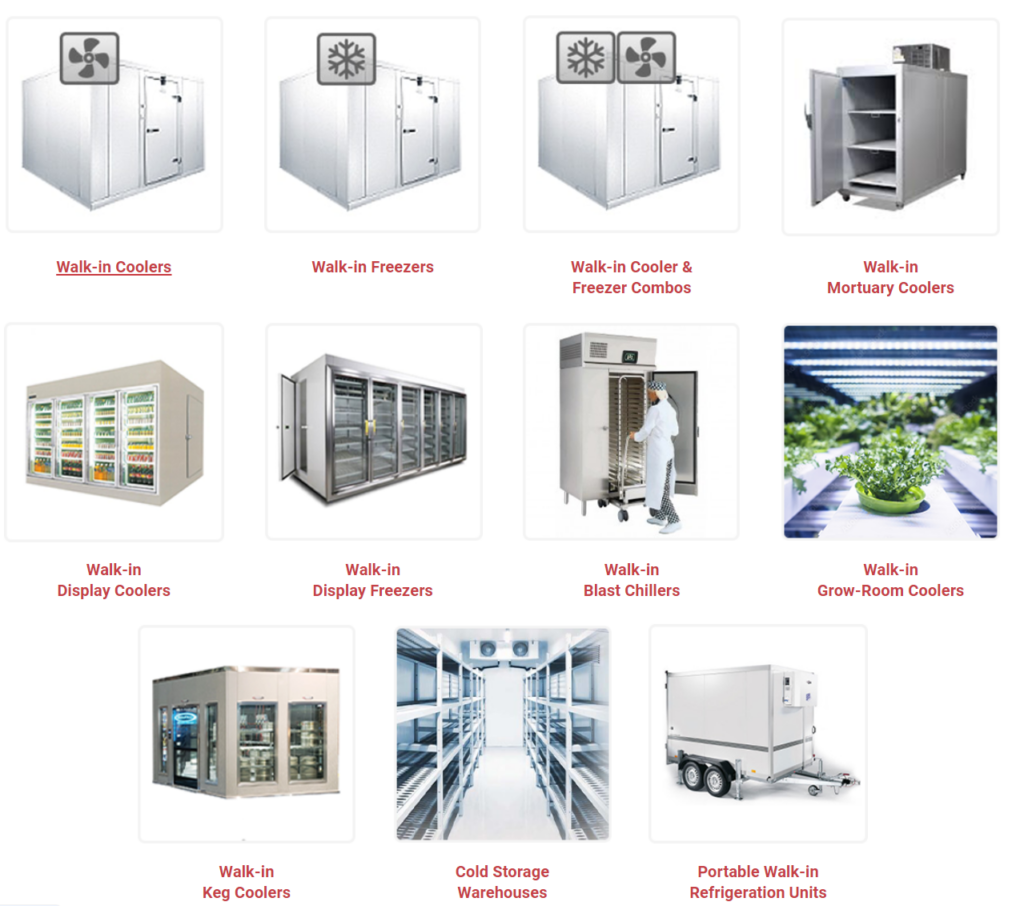
Modularity and Scalability
Modular and scalable units are great investments for businesses that are aiming to grow in the long run. Walk-in units are large investments, and instead of discarding them once your business outgrows its capacity, you can expand them to meet your increased demand. Expandable units can be scaled up with extra panels to increase the unit’s capacity. Panel integration is relatively easy and seamless since such units are initially manufactured with scalability in mind.
Reconfigure the interior design to adapt to inventory changes in addition to scaling the unit to accommodate more products. Modular systems refer to adjustable building blocks to accommodate different needs over time. Walk-in unit shelves are modular in the sense that you can easily rearrange them to make more room, add more shelves, change the material and type of the shelves, remove some to allow more foot traffic, and more. The freedom to redesign the interior of the unit will make transitions in inventory easier and even raise the resale value of the unit.
Cooling System
Self-contained systems and remote-condensing systems are two primary cooling systems for walk-in refrigeration. They are carried out by the condenser component of the units, and each cooling types offer distinct advantages suited to different operational requirements. The option you choose impacts installation location, noise levels in your space, maintenance access for technicians, and interior space design.
- Self-Contained System: Self-contained walk-ins are the most common type among pre-fabricated units. The name refers to the fact that the condenser and the evaporator are located inside the fridge. The entire cooling system is in one place, which allows straightforward installation and maintenance. It makes moving the unit easier since you don’t need to dismantle and move parts separately. It is worth noting that the condenser is the noisiest component of a walk-in, and having it within the kitchen can prove disturbing for you and your staff. The cooling mechanism expels heat, which could lead to your AC overworking if your ventilation isn’t strong enough.
- Remote-Condensing System: Remote-condensing systems position the condenser externally, enhancing efficiency and minimizing noise pollution within your kitchen. Removing such nuisances from your workspace will positively impact staff efficiency and create a better environment while opening up more space within the unit. This method makes it harder to carry out maintenance on the whole unit at once, requires you to connect the condenser to the unit with additional materials, and makes it harder to move the unit if you have to.
Self-contained units are more optimal for smaller establishments with space constraints, prioritizing simplicity and compactness, whereas remote systems could prove more efficient for larger operations, prioritizing enhanced performance and noise reduction.
Energy Efficiency Options
Walk-in refrigerations are equipped with green technologies that offer various benefits, like being cheaper and more eco-conscious. If you’re looking to reduce your establishment’s carbon footprint, you should incorporate energy-efficient systems.
- High-Efficiency Systems: Most modern walk-in refrigerators have high-efficiency compressors and evaporators. These compressors and evaporators minimize energy consumption while maximizing cooling efficiency. They reduce costs by providing better performance with less power consumption.
- Eco-Friendly Refrigerants: Traditional refrigerants like R-22 are notorious for harming the ozone layer and contributing to global warming. Modern refrigerants that are more eco-friendly, like R-404A and R-290, have significantly lower environmental impacts. You can align with sustainability goals and reduce your carbon footprint by using these eco-friendly options in your establishment.
- LED Lighting: LED lighting is the standard for modern walk-in refrigerators. It consumes significantly less energy than traditional fluorescent lights and has a longer lifespan. By minimizing the heat output, LED lights tire the cooling system less.
- Smart Defrosting Systems: Smart defrost systems help you optimize defrost cycles in real-time, saving much more energy than traditional, energy-intensive defrost cycles.
- Smart Controls: Smart controls play a crucial role in decreasing your carbon footprint and making your establishment more energy efficient. They use cutting-edge technology to automate your energy usage and temperature regulation, resulting in minimal energy waste and optimal performance.
- Temperature Monitoring and Adjustment: Smart controls monitor temperature levels in the walk-in refrigerator continuously and make real-time adjustments to ensure ideal conditions. These systems preserve large amounts of energy and the freshness and quality of your ingredients and goods by preventing temperature fluctuations.
- Adaptive Cooling Algorithms: These advanced algorithms analyze your establishment’s usage patterns and conditions to optimize cooling cycles. By optimizing the cooling cycles, these algorithms provide minimal energy usage and efficient cooling.
- Remote Monitoring and Management: Multiple smart control systems have remote monitoring and management capability features. These features allow you to monitor the temperature levels and system performance from anywhere in the world with your computer or smartphone. This way, you can stay on top of your work, help with proactive maintenance and troubleshooting, and reduce the risk of inefficient energy usage and costly downtime.
Access Requirements
The number and type of access points to the walk-in depends on your space and workflow. Most standard units have single entry points, which prove sufficient for small-scale businesses since the need to go in and out of the unit is limited, and the staff is small in number. Frequent use over the years eventually harms the door hinges and leaves the unit vulnerable to leaks. Such issues can be minimized by having a single door and making maintenance easier. Larger establishments need multiple entry points to accommodate increased staff numbers and foot traffic. Accessing from different points makes it easier to locate and retrieve products and saves you time during work hours, especially if the unit is large.
You should consider the type of door you will have on your unit. Sliding doors and swinging doors are two main options. Sliding doors are great options for tight spaces since they don’t need clearance at the front. Hinged swinging doors are more traditional options. They do need clearance at the front to open without issue, but they provide more secure sealing compared to sliding doors. They are more durable, too, which makes them popular choices among business owners.
Compliance and Certifications
Ensuring compliance and certification of walk-in coolers and freezers is important for all types of businesses. Consider your particular industry’s local and federal regulations and codes and purchase a unit that complies with those rules as well as carries the necessary certifications. Most regulations and codes are related to meeting health and safety standards, such as those set by NSF, FDA, or USDA, since walk-ins are most frequently used in food service, and it is crucial to guarantee the safe storage of perishable goods for public health and safety.
These walk-in safety and health standards dictate design specifications, usage guidelines, and maintenance and cleaning expectations. For instance, FDA guidelines dictate that products like chicken that are prone to quick spoilage and leaking should not be stored on the top shelves, where they may leak and endanger other products.
Obtaining energy certifications like EPEAT demonstrates a commitment to sustainability and efficiency, which should be a high priority for all businesses to reduce their carbon footprint and bill costs. Not only do such certifications signify lower operational costs, but they also open avenues for potential rebates and tax benefits for going green. By prioritizing compliance and certification, businesses can uphold the highest standards of safety, quality, and efficiency in their walk-in cooler and freezer systems.
What Materials are Used in Walk-ins?
Walk-in unit exteriors are made up of three main layers: the metal panels and the insulation layer sandwiched in between. The metal panels, known as skins, need to be made of robust, durable, corrosion-resistant material and the insulation layer similarly should perform its function well. The quality of the insulation depends on both layers, and it is measured through the R-value. The industry standard for walk-in coolers is R25 however, going for an R30 model can save you more money since a well-insulated unit will work less to maintain the coolness.
The South Carolina Department of Agriculture suggests using polystyrene, especially for the floors, and having it at least 4” (10.16 cm) thick for both the floor and the walls. A thicker insulation layer can lighten the load of the condenser and help retain cool temperatures better.
Insulation
Insulation is an essential component in Walk-ins for several reasons. It helps maintain consistent temperatures in the walk-in refrigerator, reduces the workload, makes the walk-in more energy efficient, and prevents mold or damage by preventing condensation.
There are two main types of insulation you can find in refrigeration products, alongside some fairly new types of insulation.
- Polyurethane: Polyurethane is a common type of insulation. While it performs pretty well in high-temperature areas, machines with this type of insulation have been discovered to perform poorly once the temperatures fall.
- Polystyrene: Polystyrene, on the other hand, is a newer type of insulation. They are used in machines and environments that require higher R-values, and they work pretty well in colder temperatures, unlike their polyurethane counterparts.
Metal Skin
Panels serve as the structural walls of walk-ins and are responsible for the insulation of the equipment. They comprise two metal sheets, often referred to as skins, with an insulating layer sandwiched between them; these panels typically measure between 3.5″ and 5″ (8.89 to 12.7 cm) in thickness, depending on the insulation material. It is crucially important to ensure that the metal skin exhibits resistance to corrosion and damage.
- Galvanized Steel: Despite being a robust and dent-resistant choice, the high cost of galvanized steel has led to its decreased popularity.
- Aluminum: Aluminum is known for its corrosion resistance and relatively lower cost compared to steel alternatives However, it is susceptible to denting and lacks the same level of durability. When you’re opting for aluminum panels, it is highly recommended to increase the thickness as much as possible to compensate for the lack of durability.
- Stainless Steel: Stainless steel is among the most popular materials. It stands out for its exceptional corrosion resistance and durability. Despite being pricier, investing in stainless steel panels guarantees increased longevity and efficiency for your walk-ins.
Conclusion
The types and uses of walk-in coolers and freezers present diverse options to meet the demands of various industries. To ensure optimal functionality and longevity of these essential pieces of equipment in your specific industry, businesses must carefully consider 9 key factors: location adaptability, construction type, industry-specific features, modularity, and scalability, the choice between self-contained and remote-condensing systems, energy efficiency, access requirements, compliance with health, safety, and energy standards, along with the types of materials used in the unit’s construction. By addressing these considerations comprehensively, businesses can maximize the benefits of their investment in walk-in coolers and freezers while adapting to evolving industry demands.

